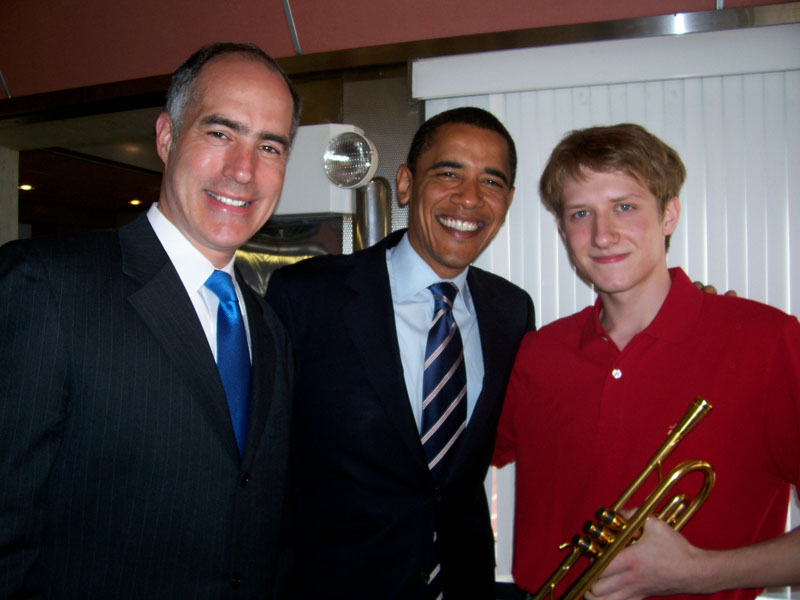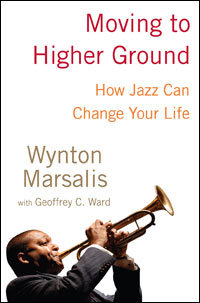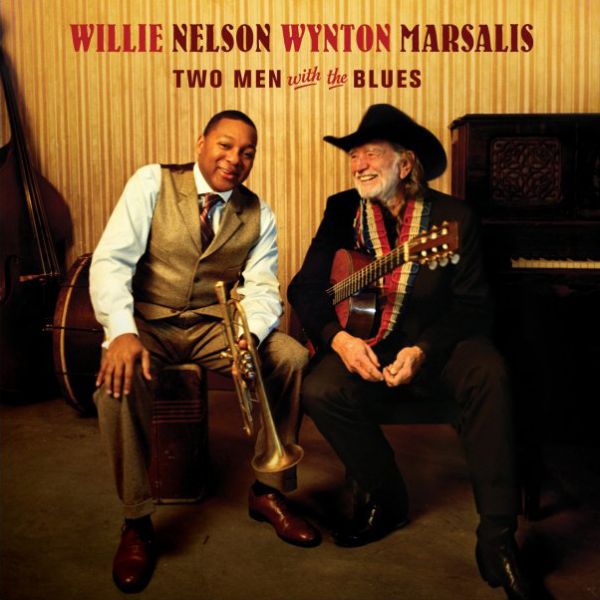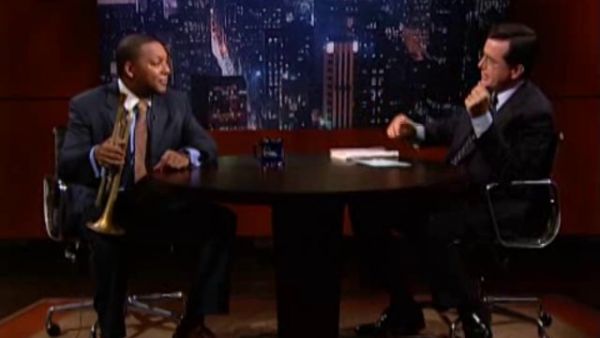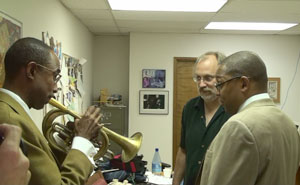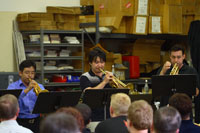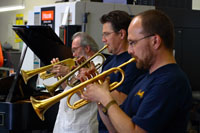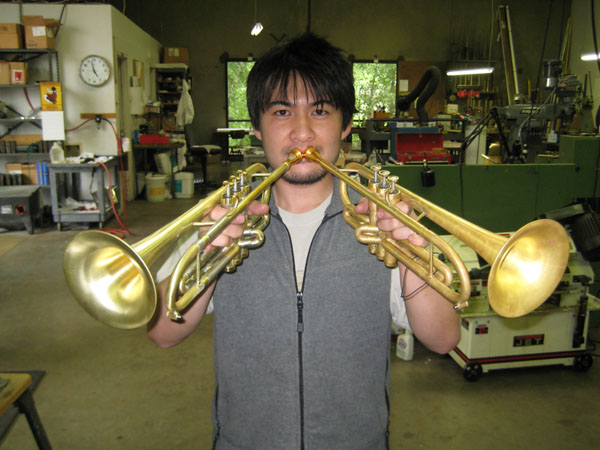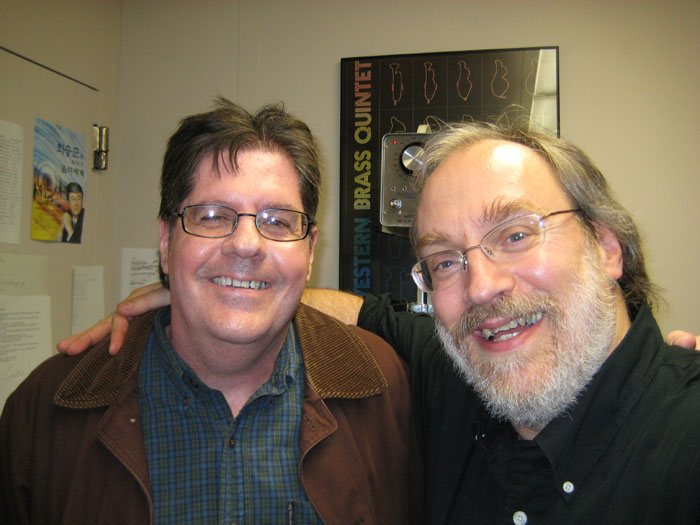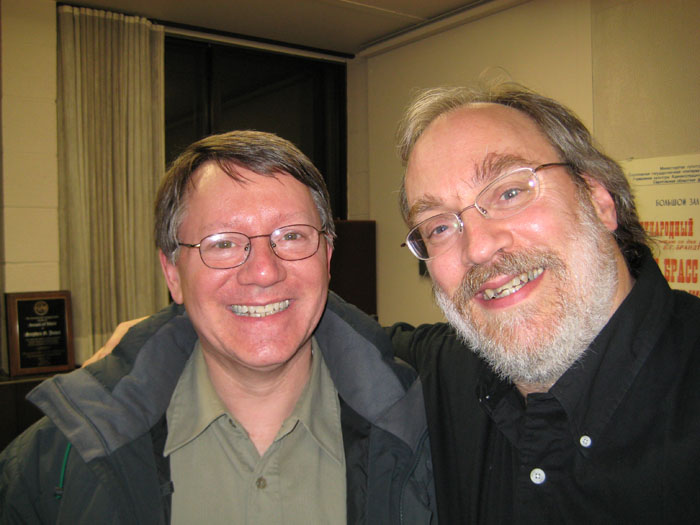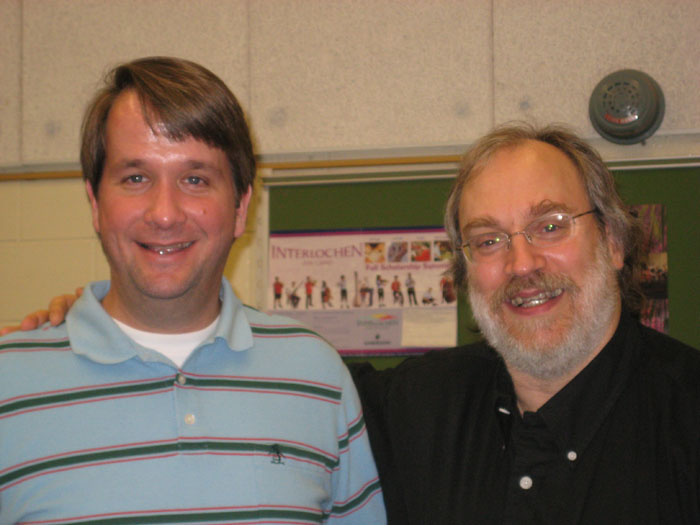New! Prana Mouthpiece Acclimation Tips:Body Use and Breath
The response to PRANA mouthpieces has been overwhelmingly positive! Most PRANA owners report they immediately find an improvement over their previous mouthpiece, and the more they play their PRANA mouthpiece the better it gets. Acclimation does vary from player to player, depending on their muscle memory, their concept of playing and probably most importantly how they use their bodies when they play.
This link is designed to help everyone who owns a PRANA mouthpiece reduce their "transition time" as they acclimate to the advantages these new mouthpieces provide. By using the following material on body use and breath, the acclimation time for these new mouthpieces can be reduced from days or weeks to hours or even minutes!
"PRANA Mouthpiece Acclimation" from page 17 of our 2004 printed newsletter:
PRANA MOUTHPIECE ACCLIMATION
The physical approach that allows Prana mouthpieces to be an immediate advantage is the same physical approach that players such as Wynton Marsalis and Maynard Ferguson have had for their entire careers. The "secret" is simply to align your entire body so that you can take a full, complete, relaxed breath every time you play. To that end, for many players, the "secret" to instant acclimation to Monette equipment and to PRANA mouthpieces in particular is actually in the feet and hips. Please read on!
DEMONSTRATION - Body Use and Breath
Evaluating How You Currently Play - Standing
Step 1: Stand the way that your normally stand when playing, and play up to a high C.
Step 2: Hold that body use while playing the high C, and stop playing. Make sure you do not "recoil" your head away from the mouthpiece and back over your spine at the moment you stop playing… just keep everything in your body and your horn position the same as when you are playing, but stop playing.
Step 3: Take a full, deep breath, and notice as you fill the lungs up from bottom to middle to top at what point coming up the chest you start to feel resistance on the inhale. You can use your right hand to follow the breath up the chest, and stop your hand at the point you feel resistance or constriction. Look down at your hand position.
Comments:
Almost universally, players will not be able to breathe freely all the way up the chest. The constriction usually starts around the breast level or below! In clinics we give, usually only one person in 100 has their hand up in the top half of their chest.
If you can't breath freely when playing, you are playing "tight" and "high on the pitch." This approach may have worked well when using your old equipment, however it is "more work" than we recommend when using Monette equipment. Please read on for specifics on how to align and breath more efficiently.
Opening the Knees, Hips, Chest and Throat when Standing
Step 1: Stand with your feet hip distance apart.
Step 2: Make your feet parallel.
Step 3: Bend or at least unlock your knees. This is extremely important.
Step 4: Move your hips and rear end backwards until you feel your body weight evenly distributed front to back on your feet. You will also feel your thigh muscles relax as you "ground" through your leg bones and feet into the floor. At this point you will feel like you are falling forward, however your body is now vertical. This allows your bones to support most of your body weight rather than mostly using your muscles.
Once again, remember that it is common to feel like you are falling forward at this point. The weight distribution on your feet, a full length mirror, a nearby wall, or a video camera as a reference to where "vertical" is can be very helpful. Once you get used to standing in a more aligned and efficient manner, you will wonder why you waited so long to change!
Step 5: Once again, bend or at least unlock your knees, which have probably locked again now that you have opened your hips and are standing upright in a new way.
Step 6: Tuck in your chin more than you are used to, and lower the bell of the horn slightly - but not to the point of being uncomfortable. This places your head over your spine and elongates the neck, which opens the throat. (If you have watched the online video featuring the new PRANA instruments, you will notice that every artist tucks in their chin when they play throughout the range of the instrument. It is extremely important!)
Step 7: Take the same full, relaxed breath, and notice how much further the breath travels up the chest. Even the sound of your breath coming into your body will sound fuller and more complete, and you will be probably be startled at how much easier it is to breath.
Comments:
Now, push your tuning slide in somewhere between 1/16th of an inch and 1/8th of an inch more than you normally have it. Practice bringing your horn and mouthpiece 100% of the way up to your lips, rather than bringing it most of the way up and then moving your head forward of your spine in order to play. Also notice that as you bring your horn up to play, the tendency is to lock your hips forward and raise your shoulders. Both of these practices make you "tight" and inhibit the breath.
Now play with this new, more efficient body use. Be sure to bend or at least unlock your knees and keep the bell of your horn slightly lower than you are used to. Notice how your upper register locks right in, how your sound is fuller and projects better, and how much more secure the response of your instrument feels. Also, notice how the standard intonation problems when playing octaves, fifth partial, etc. are immediately improved.
It will still take some time to learn to automatically align yourself in this new way when playing, but using the above method gives you specific physical techniques for immediately breathing easier and playing better.
Evaluating How You Currently Play - Sitting
Step 1: Sit the way that you normally sit when playing, and play up to a high C.
Step 2: Hold that body use while playing the high C, and stop playing. Make sure you do not "recoil" your head away from the mouthpiece and back over your spine at the moment you stop playing… just keep everything in your body and your horn position the same as when you are playing, but stop playing.
Step 3: Take a full, deep breath, and notice as you fill the lungs up from bottom to middle to top at what point coming up the chest you start to feel resistance on the inhale. You can use your right hand to follow the breath up the chest, and stop your hand at the point you feel resistance or constriction. Look down at your hand position. Please note that the breath will probably be slightly easier than standing, depending on how you are sitting.
Step 4: Almost universally, players will not be able to breathe freely all the way up the chest. Again, the constriction usually starts around the breast level or below.
Comments:
If you can't breath freely when playing, you are playing "tight" and "high on the pitch." This approach may have worked well when using your old equipment, however it is "more work" than is needed when using Monette equipment.
Opening the Knees, Hips, Chest and Throat when Sitting
Step 1: Sit all the way back in your chair, but with your upper back away from the chair. A rolled up bath towel between the small of your back (lumbar) and the back of the chair is a great alignment tool! (If you like this, wedge-shaped lumbar pillows are available from any chiropractic store or back store).
Step 2: Place your feet parallel, hip distance apart.
Step 3: Place your knees behind your feet, so they are not splayed out to the sides. This may feel uncomfortable, but stay with it.
Step 4: Tuck in your chin more than you are used to, and lower the bell of the horn slightly - but not to the point of being uncomfortable. This places your head over your spine and elongates the neck, which opens the throat.
Step 5: Take the same full, relaxed breath, and notice how much higher the breath travels up the chest. Even the sound of your breath coming into your body will sound fuller and more complete, and you will probably be startled at how much easier it is to breath.
Comments:
Now, push your tuning slide in somewhere between 1/16th of an inch and 1/8th of an inch, and play with this new, more efficient body use. Be sure not to splay the feet or knees. Notice how your upper register locks right in, how your sound is fuller and projects better, and how much more secure the response of your instrument feels. Also, notice how the standard intonation problems when playing octaves, fifth partial, etc. are immediately improved.
It will still take some time to learn to automatically align yourself in this new way when playing, but using the above method gives you specific physical techniques for immediately breathing easier and playing better.
![]()














































































